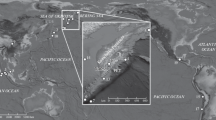Conclusions
-
1.
The most probable location and dimensions of residual deformations that could develop during an 8-point earthquake are determined by a review and analysis of the geological and seismotectonic conditions of the region in which the reservoir for the Zhinvala hydroelectric plant is being constructed. The kinematic characteristics of the primary (seismotectonic) and secondary (slide) residual deformations are evaluated.
-
2.
The above-cited data are used to estimate the height of waves generated in the reservoir during various seismic events.
-
3.
The results of specific numerical computation from Eq. (2) indicate that the maximum increase in the water level near the Zhinvala hydroelectric plant dam resulting from a slide from the bank in the right branch of the reservoir is 2.7 m; this is almost three times the value of this increase in the case of seismotectonic displacements in the right or left branches of the reservoir. The oscillation periods of the water range approximately from 3 to 14 min for all cases.
-
4.
Computations performed on an electronic computer from the equation derived for the effects on the dam and reservoir bottom of seismic vibrations indicated that the maximum amplitudes of waves generated on the surface of the water will not exceed 1 m.
Similar content being viewed by others
Literature Cited
Construction Norms and Specifications II-A. 12–69, Construction in Seismic Regions. Section 5. Hydraulic Structures [in Russian], Moscow (1972).
T. L. Gvelesiani, “Seismic seiches in branches and bays of reservoirs where a portion of their channels are subjectdd to vertical displacement resulting from an earthquake,” Communications of the Academy of Sciences of the Georgian SSR [in Russian], Vol. 52, No. 2 (1968).
G. P. Mamradze and T. L. Gvelesiani, “Wave formation in a reservoir with its bottom deformed as a result of a tectonic earthquake,” News of the Tbilisi Scientific-Research Institute of Construction and Water Power Engineering [in Russian], No. 18, Énergiya, Moscow (1969), p. 52.
T. L. Gvelesiani, “Computing a seismic wave on the water surface in a reservoir,” Proceedings of Coordination Conferences on Hydraulic Engineering. The Earthquake Resistance of Large Dams. Supplementary Data [in Russian], Énergiya, Leningrad (1973).
T. L. Gvelesiani, “Investigations of seismic seiches in a reservior, which generate residual shear deformations and displacements of its shores as a result during an earthquake,” Communications of the Academy of Sciences of the Georgian SSR [in Russian], Vol. 76, No. 1 (1976).
T. L. Gvelesiani, “Study of water-level fluctuations in a reservoir with seismotectonic displacements of its basin,” in: Water-Power Construction under Mountain Conditions [in Russian], No. 2, Énergiya, Moscow (1974).
T. L. Gvelesiani and G. V. Amonashvili, “An algorithm and program for computing the height of a wave in a reservoir with the development of residual (seismotectonic) deformations in the region of its basin,” Proceedings of the Symposium of GÉS-73 Computer Specialists of Foreign Nations—Members of the Council for Mutual Economic Aid and Socialist Federated Republic of Yugoslavia [in Russian], Leningrad (1973).
L. G. Gvelesiani and L. A. Éliava, “The Zhinvala hydroelectric power plant on the Aragvi River,” Gidrotekh. Stroit., No. 4 (1975).
V. I. Byus and A. D. Tskhakaya, “The bases for the seismological division of the Kavkaz,” Byull. Soveta po Seismologii, No. 8, Moscow (1960).
T. L. Gvelesiani, “The problem of predicting seismotectonic deformations in a reservoir basin,” Proceedings of the Coordination Conferences on Hydraulic Engineering [in Russian], Énergiya, No. 94, Leningrad (1974).
T. L. Gvelesiani, “Determination of the geometric characteristics of seismotectonic deformations,” Technical Information. Construction and Architecture [in Russian], Gosstroi GSSR, No. 7, Tbilisi (1975).
N. V. Shebalin, “Relationship between point scale and the intensity of earthquakes as a function of the depth of the epicenter,” Byull. Soveta po Seismologii, No. 6, Moscow (1957).
T. V. Orlov, N. S. Poleshuk, and A. V. Stankeev, “Apparatus and method used to record automatically and process experimental data on a digital computer in studying discontinous waves,” Proceedings of the Coordination Conferences on Hydraulic Engineering [in Russian], No. 51, Énergiya, Leningrad (1969).
Additional information
Translated from Gidrotekhnicheskoe Stroitel’stvo, No. 6, pp. 18–21, June, 1977.
Rights and permissions
About this article
Cite this article
Gvelesiani, T.L. Determining water-level fluctuations in a reservoir under seismic conditions with the Zhinvala hydroelectric plant cited as an example. Hydrotechnical Construction 11, 569–574 (1977). https://doi.org/10.1007/BF02413416
Issue Date:
DOI: https://doi.org/10.1007/BF02413416




